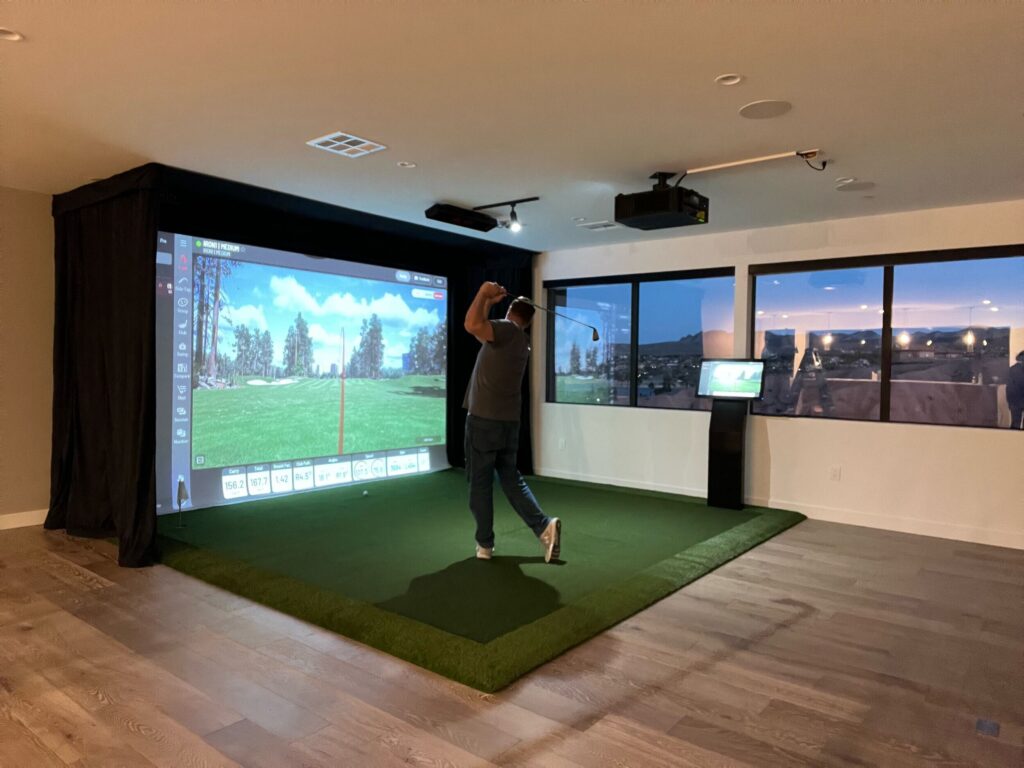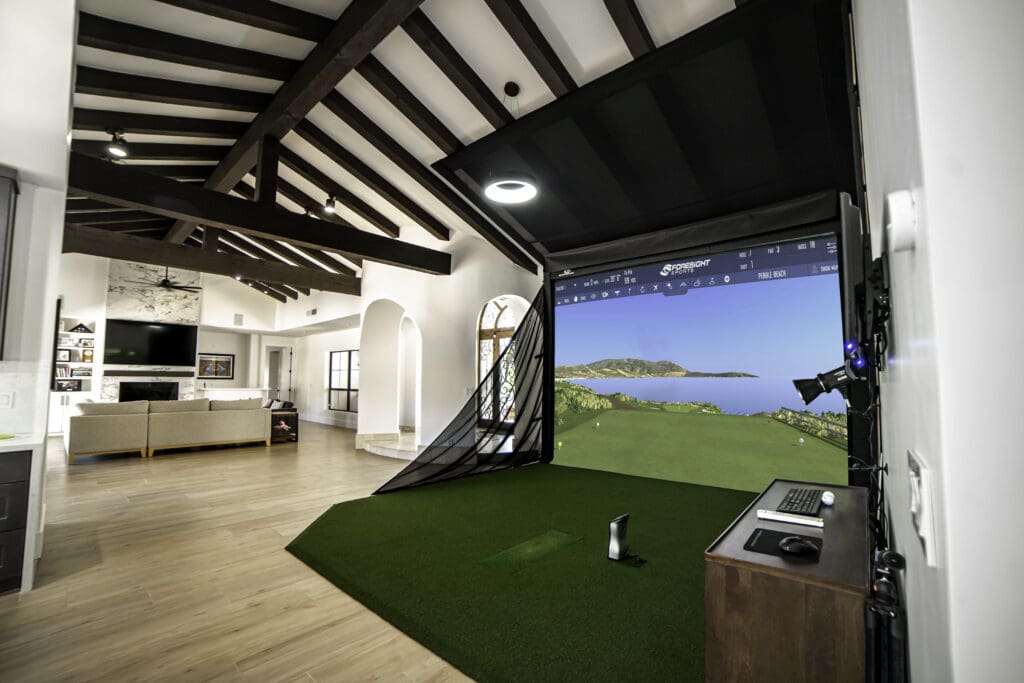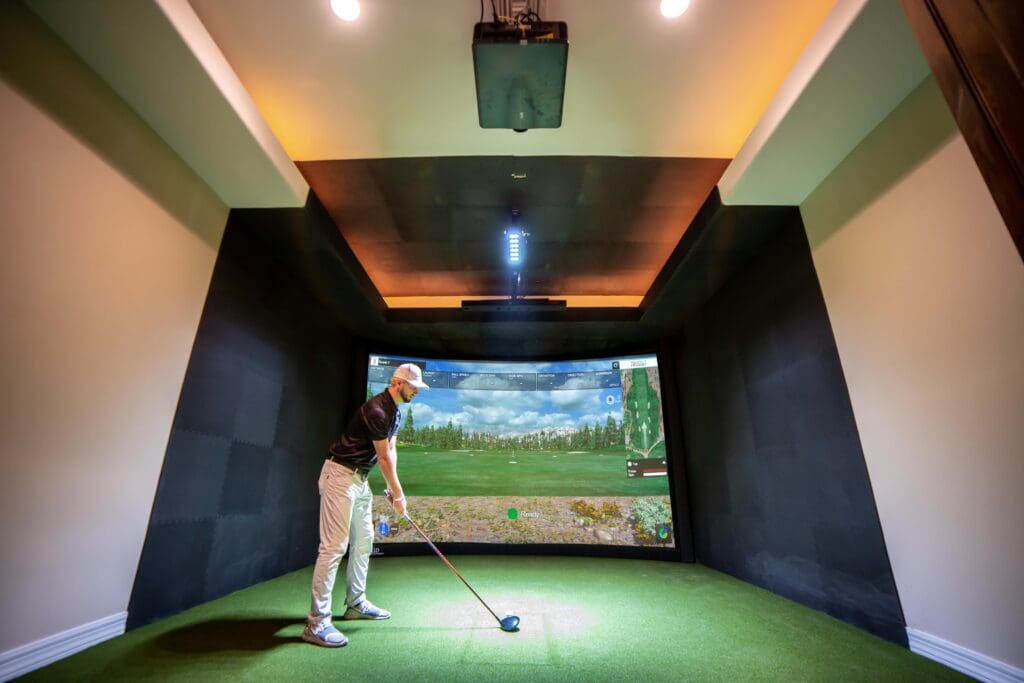How Accurate Are Golf Simulators
Golf simulators are surprisingly accurate, especially when kitted out with the latest in tracking tech like high-speed cameras, infrared sensors, and radar systems. The accuracy depends on the quality of these tools and how you set up your space. You’ll want consistent lighting and temperature, and ensure nothing obstructs the area to get the best results.
When you’re hitting drives or practicing your putts, these simulators give you detailed feedback by mimicking the real-world physics of a golf course, including factors like wind and terrain variations. If you’ve ever been annoyed by shots that veer off course, a well-calibrated simulator could become your go-to practice buddy. Seeing how these devices can help step up your game is fascinating.
So, whether you’re a seasoned pro looking to refine your technique or a weekend golfer aiming to improve, investing in a golf simulator can provide valuable insights and a realistic playing experience, all from the comfort of your home.
Factors Affecting Golf Simulator Accuracy

When you gear up for a session on a golf simulator, a few crucial elements dictate how accurate it will be. First, the quality of the tracking technology and the simulation software play a massive role. These need to be top-notch to ensure that the feedback you get is as close as possible to playing on an actual course. Besides this, setting up the equipment correctly and maintaining a consistent environment is just as vital for a realistic golfing experience.
Imagine you’re practicing with a simulator that uses state-of-the-art sensors and highly detailed, up-to-date software. Every swing you take gets measured with precision, capturing the intricacies of your technique. This detailed feedback can be incredibly beneficial, especially if you want to improve specific aspects of your game.
Now, think about the environment where you set up your simulator. Consistent lighting, no drafts, and a temperature-controlled room can make a big difference. It’s like how professional players would consider the weather and course conditions in real life.
Tracking Technology Quality and Type
When you’re teeing off in a golf simulator, the precision of the tech that tracks your swing—like high-speed cameras, infrared sensors, or radar—is crucial for nailing that shot’s accuracy. The advanced tracking tech in high-end setups, often seen in pro spaces, can mimic real-life play much closer than the simpler versions in budget-friendly, at-home simulators. This level of precision should reassure you about the accuracy of the simulator.
Environmental Setup Conditions
Creating the perfect environment for your golf simulator is critical to getting the most out of your practice sessions. Start by making sure the lighting in the room is even and soft—shadows or bright spots can throw off the sensors and mess with your results. It’s like setting the stage for an excellent performance where every detail counts.
Next, give yourself plenty of room to swing. Imagine having enough space to swing a bat without hitting anything; that’s the freedom you need. If you’re cramped, your swing might tweak, skewing the data you get back. You want your practice to mirror real-life conditions as closely as possible.
Speaking of real-life conditions, the surface you’re playing on should feel just like the fairway. Whether it’s artificial turf or a specially designed mat, it should mimic the feel of a golf course to give you accurate feedback on your shots. For example, if the surface is too hard, the ball might bounce more than it would on a real fairway, leading to inaccurate data. Similarly, if the surface is too soft, the ball might sink in, affecting its trajectory.
Also, watch for any metal objects or mirrors around your setup. These can interfere with radar-based systems and could lead to inaccurate data. It’s like having a noisy background when trying to listen to music—those extra sounds don’t help.
Simulation Software and Physics
Why is the simulation software such a game-changer for your golf simulator’s precision? Well, it’s all about how the software processes the data from your swings and then uses it to simulate the ball’s flight in the virtual world. High-quality simulation software precisely mirrors real-world dynamics by considering factors like the ball’s initial speed, launch angle, spin, and how it would respond to various elements like wind, terrain, and spin.
If the algorithms in the software are lacking, you’ll start seeing mismatches between how you play on the course and what happens in the simulator. This can be frustrating, especially when you’re working hard to improve your game, and it doesn’t seem to reflect in the virtual environment. Spot-on software ensures that every little detail of your shot is captured and reproduced accurately, making your practice sessions much more valuable.
This high level of accuracy helps enhance your training and builds trust in the technology, ensuring that the time you invest in using the simulator translates effectively into real-world results. By ‘real-world results,’ we mean that the improvements you make in your swing, technique, and understanding of the game through simulator practice can be directly applied to your performance on an actual golf course. Remember, every tiny aspect of your game, from the swing to the follow-through, is essential. Good software recognizes and respects that by providing feedback as real as hitting the links. This helps sharpen your skills and understanding and adjust you to the nuances of your play style.
Golfer’s Swing Consistency/Repeatability
The accuracy of your golf simulator depends on how consistent and repeatable your swing is. If your swing changes from one shot to the next, the simulator might struggle to predict where your ball will end up accurately. But if you can keep your swing consistent, the simulator will give you back some reliable and precise data.
When practicing, focus on fine-tuning your technique so every swing feels almost identical. This isn’t just about getting better at the game out on the course; it’s about helping the simulator give you the best feedback possible. Keep everything from your posture to your grip and swing mechanics as consistent as possible. The more uniform your actions, the easier it is for the simulator to track what you’re doing and analyze your performance correctly.
Calibration and Proper Setup
To ensure your golf simulator delivers precise accuracy, it’s essential to calibrate and align the tracking system properly during setup. Remember, this isn’t just a one-off task.
If you frequently move your setup, you’ll need to recalibrate it regularly. Even minor shifts can mess with the system’s accuracy, which can throw off your practice sessions.
Imagine perfecting your swing only to receive inaccurate feedback because the system wasn’t adjusted after the last move. Regular checks on the alignment are crucial to ensure each swing is accurately measured.
This keeps your training effective and helps improve your game consistently. Don’t let a minor negligence derail your progress!
Accuracy: High-End vs Lower Cost Simulators

When we dive into the world of golf simulators, it’s like comparing the precision of a Swiss watch with a reliable everyday timepiece. High-end simulators, such as Trackman, are the Swiss watch in this analogy. They use cutting-edge tech like high-speed cameras, infrared sensors, and advanced radar. These tools are so detailed that they pick up everything from the speed of your swing to the twist of your club at impact. This means they can mimic your golf ball’s exact curve and dip with stunning accuracy.
On the flip side, if you’re not looking to break the bank, there are some pretty solid choices, too. Lower-cost simulators might use more straightforward tech, like primary cameras or radar, which does a decent job. But they might miss some of the subtleties the high-tech setups catch. This could mean less feedback on the finesse parts of your game, like the slight spin you put on a drive.
However, it’s not all doom and gloom for the budget-friendly options. Simulators like SkyTrak and Uneekor QED are showing up and showing off, delivering performances that punch way above their weight class, nearly rivaling their pricier counterparts. These are a sweet spot for amateur golfers—affordable yet effective, giving you a good bang for your buck.
Simulating Different Shot Types
Ever find yourself struggling with putting? Well, these simulators are here to assist. They help you refine your putting techniques and boost your confidence on the green. It’s like having a personal coach who guides you through each swing and putt, ensuring your practice sessions are as practical as possible.
Chips and Flop Shots
Exploring how golf simulators handle chips and flop shots can be enlightening, especially with their precision in capturing these complex short-game shots. The advanced camera-based systems excel here. They track the ball in 3D right from when it leaves your club. What’s remarkable is how they measure crucial things like the launch angle, ball speed, and spin rates. This tech wizardry enables the simulator to replicate your shot’s trajectory and how it gently lands on the virtual green with remarkable accuracy.
But here’s a heads up: if you’re looking at more budget-friendly simulators that only use radar technology, you might notice they fall short with softer, slower shots. These shots require a delicate touch, and sometimes, the radar-based systems don’t capture all those subtle details, which might lead to a less precise simulation of your chip and flop shots.
Putting
When you’re using a golf simulator to practice putting, it’s all about capturing the natural feel of the game. These simulators are pretty clever—they pay close attention to how fast your ball is moving and the direction it’s launched. Plus, they get really into mimicking the green’s contours and textures. This detail helps bring the whole experience to life, making it feel like you’re out on the course.
The tech behind this involves some intelligent ball tracking combined with a deep dive into the physics of how your ball behaves on different surfaces. You can try putts from various distances and see how they’d play out in real life. The quality of the putting surface you practice on makes a huge difference, too. Whether an essential mat or a high-end simulated green, it changes how the ball rolls and responds.
If you’re practicing on a high-end simulator, you’ll notice that your putts behave pretty much like they’d on a natural green. This is great for fine-tuning your technique and building up your confidence. Practicing in conditions that mimic the natural greens as closely as possible is crucial to sharpen your skills.
Equipment Requirements for Maximum Accuracy

To get the most out of your golf simulator, it’s crucial to match your equipment to the system’s needs. Top-of-the-line simulators like Trackman, Full Swing, and Foresight GC3 work perfectly with standard golf clubs and balls. Thanks to their advanced camera technology, these systems capture every detail of the ball and club at the moment of impact, ensuring your measurements are spot-on.
However, not every simulator operates the same way. Take the radar-based Uneekor QED, for example. To get the best results, you’ll need to stick reflective markers on your club faces. It might seem like a tiny tweak, but it enhances the shot-tracking accuracy.
If you’re on a budget, simulators like the Rapsodo MLM2 Pro might suggest using specially marked balls, like the Callaway RPT, to get accurate spin rates. It’s a smart way to tap into advanced analytics without spending a fortune.
The environment you play in matters, too. For putting, investing in a high-quality surface that mimics natural greens can make a huge difference in realism, taking you beyond the basic mat setup. These details help bring the feel of an outdoor course into your home.
No matter what gear you’re using, remember that calibration is critical. Even with the right clubs and balls, things like room lighting and the quality of your hitting surface can affect your simulator’s accuracy. Make it a habit to recalibrate your system as recommended to keep getting the most accurate and genuine feedback. After all, the more precise your practice, the more accurate your play.
Conclusion
In conclusion, whether you choose a top-tier simulator or a more wallet-friendly version, the precision they offer is quite comparable to actual gameplay. It’s crucial to use good-quality equipment and grasp the limitations inherent in the technology.
No simulator is flawless, but they’re an excellent resource for honing your skills under various conditions. Embrace this technology, tweak your expectations, and you’ll likely find both challenge and enjoyment on the virtual course.
Want to learn more about our custom residential and commercial golf simulators? With over 20 years in the business, our expert team will help you create the golf simulator of your dreams. Contact us today or call any time at (602) 888-4018
